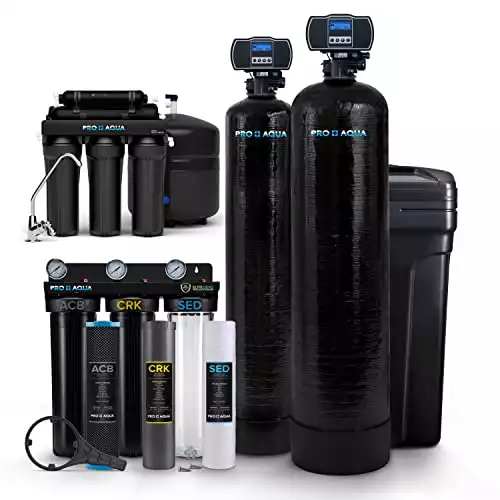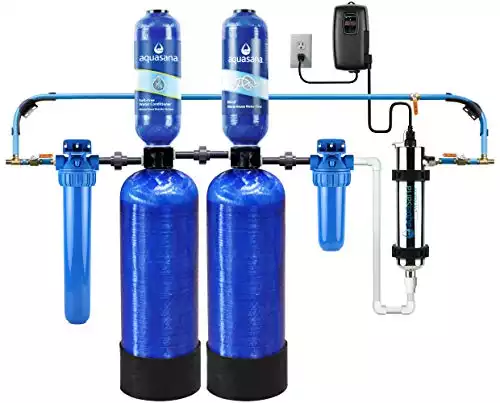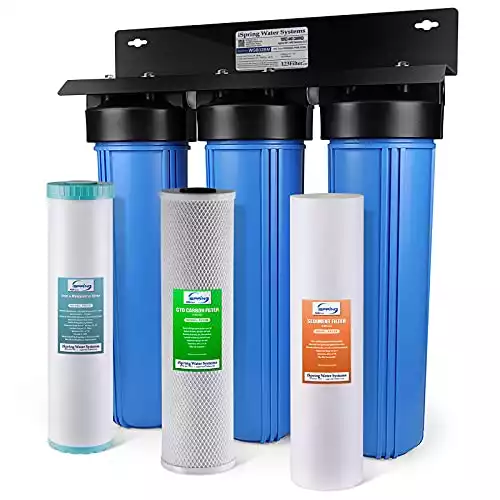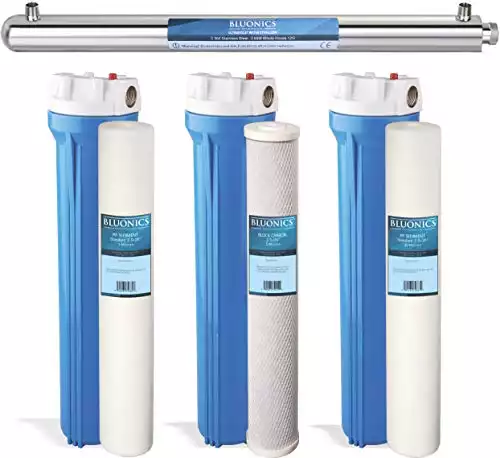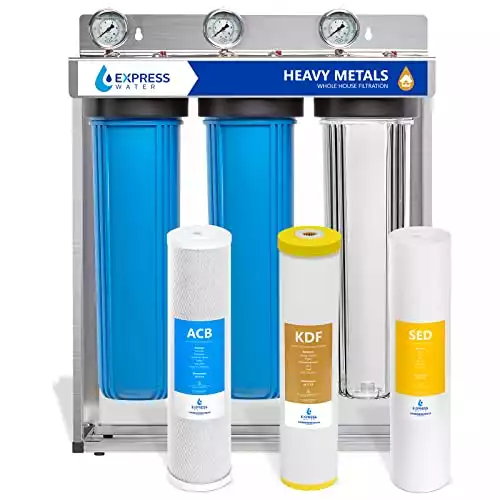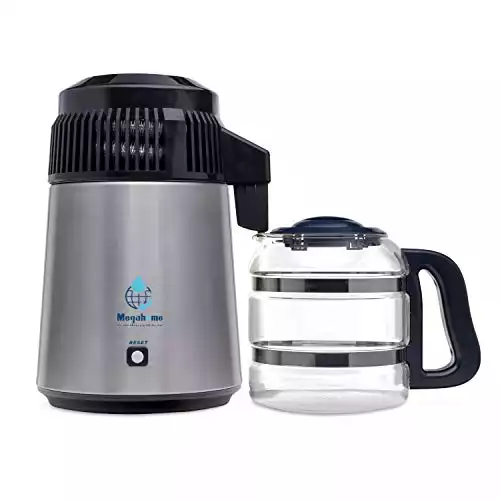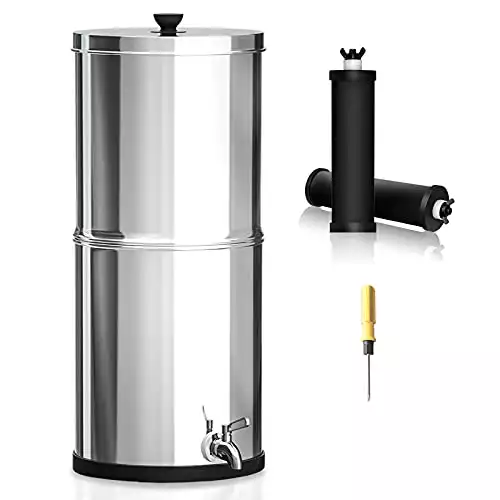One potential disadvantage of a private well is poor water quality, including the risk of contamination from volatile organic compounds and foul odors and taste. Because contaminant thresholds change over time, the safest bet is to add a well water filtration system to your home.
However, finding a quality system that supports well water is no easy task. We’ve sorted through dozens of options to find the best well water filtration systems specifically designed to work with private wells in conjunction with EPA guidelines.
Top Pick
PRO+AQUA Elite Well Water Filter
The Pro+Aqua Elite is, by far, the most thorough of well water filtration systems across the board. It is the only one in our lineup that filters all six sources of contaminants identified by the EPA.
Reviews of the Best Well Water Filtration Systems
Best Overall: PRO+AQUA Elite Well Water Filter Softener Bundle
Specs:
- Capacity: 100,000 gallons
- Maximum flow rate: 22 gallons per minute
- Purification method: reverse osmosis, activated carbon, sedimentation
Pro+Aqua provides an unmatched, all-inclusive filtration system specially designed for well water. If you’re dealing with several different issues within your well water system, the Aqua Elite covers it all.
It gets rid of the dirt and debris, the nasty tastes and smells, plus the heavy metals and microorganisms that can make you sick. The system offers a full spectrum of filtration and combines a sediment filter, oxidizing iron and sulfur filters, reverse osmosis, and water softener.
Once you’ve had your water tested, you can even tailor the iron and sulfur media to match your water content. Choose a filter for high iron (FOB), high sulfur (FOC), or a combination of iron, sulfur, and manganese (FOK).
The Pro+Aqua Elite also works to remove your total dissolved solids – the only filtration system on our list that can do this.
At the end of the filtration line is a reverse osmosis system and a water softener to give you clean, great-tasting water.
The inline carbon filters are designed for easy maintenance without the need for regeneration, backwash, draining, or electricity. Additionally, these filters are equipped with an auto-clean feature that eliminates downtime. However, it’s important to note that even with these features, routine maintenance and filter changes are still necessary to keep the filtration system operating at its best.
All of these systems combined give you a complete arsenal against water contaminants, making it the best all-around option that filters up to 99% of all your well water contaminants down to 3 microns in size.
Pros:
- Reverse-osmosis system
- Reduces all six EPA contaminants
- Removes iron, sulfur, and other natural sediments
- Certified customer support specialists
- Reduces down to a 3-micron rating
- Added water softener component
Cons:
- Expensive
- Filter changes every six months
- Requires programming
Best for Microorganisms: Aquasana Whole House Well Water Filter System
Specs:
- Capacity: 500,000 gallons
- Maximum flow rate: 14.7 gallons per minute
- Purification method: ultraviolet, sedimentation
If your water tested positive for microorganisms and your well contains an influx of bacteria, the Aquasana Whole House System is your best option because it combines an ultraviolet purifier with a kinetic degradation fluxion (KDF) filter.
The UV purifier gets rid of those dangerous coliforms and viruses, and the KDF inhibits the growth of microorganisms while also minimizing heavy metal contaminants.
The system hooks into your main water line and begins with a pre-filter that sifts rust and sediments. Your water is then filtered through a salt-free water conditioner and activated carbon filter that helps remove any herbicides, pesticides, or other organic chemicals.
Finally, a post filter removes anything down to .5 microns, and the UV filter gets rid of your microorganisms.
The pre and post-filters require changes every 2 – 6 months, while the salt-free water tank and carbon filter tank last about 5 years (500,000 gallons). Replace the UV filter annually.
Be advised a salt-free water conditioner and a water softener are not the same thing.
Water conditioners only help prevent scale from forming. They do not soften water.
The Aquasana system weighs nearly seventy pounds and takes up a substantial amount of wall space. You should install it where your main water line enters the home, but be sure you have room for it. You also need an electrical outlet for the UV light.
This system is an excellent choice for ridding your water of bacteria and microorganisms with the additional advantages of sediment filtration, some heavy metals, and organic compounds.
Pros:
- Kills 99.9% of viruses, bacteria, and chlorine-resistant cysts
- Smaller micron filter replacements available
- Reduces water-soluble metals and industrial solvents
- Seamlessly integrates with house plumbing
- Does not lose water pressure
Cons:
- No TDS or nitrite removal
- Expensive
- Requires substantial wall space (57″ x 69″)
- Warranty void with self-install
Best for Nitrites: iSpring 3-Stage Whole House Water Filtration System
Specs:
- Capacity: 100,000 gallons
- Maximum flow rate: 15 gallons per minute
- Purification method: mechanical filtration, chemical absorption, ion exchange
The iSpring 3-Stage filtration system is an inline filtering system that combines a sediment filter, carbon block, and ion exchange filters installed at your main water supply line.
The filtration system is set up to remove rust, sand, and scale; foul odors and taste; and herbicides and nitrites. However, you can swap the filters to suit your needs. For example, you can double up on the ion exchange filters and remove one of the others that you don’t necessarily need.
It’s recommended that you add a spin-down sediment filter if you have a shallow well and/or your well water contains a lot of debris. Otherwise, your filters get gunked up rather quickly. These spin-down filters also help extend the overall life of your filtration system.
You can also upgrade your purchase to include a UV sterilizer if bacteria is a concern.
This system is very easy to install and requires little maintenance. You should replace the filters at least every six months or sooner if needed.
The iSpring whole house system takes substantially less room when compared to our preceding systems. Just over two feet long and 27 ¾” tall, this is a great option for smaller off-grid cabins
Pros:
- Removes nitrites, heavy metals, and organic chemicals
- YouTube videos for easy DIY installation
- Free lifetime US-based tech support
- UV upgrades available
- NSF and CEC Certified
Cons:
- Does not remove TDS or microorganisms
- Must be protected from direct sun and freezing temps
Best for Organic Chemicals: BLUONICS Whole House & Well Water System
Specs:
- Capacity: 12 gallons
- Purification method: ultraviolet, carbon block
- Maximum flow rate: 12 gallons per minute
If you live near an agricultural or industrial area, your well is bound to absorb a variety of chemicals from the soil. The Bluonics well water system utilizes a superior carbon block media to filter volatile organic chemicals out of your water.
A carbon block filter works much better than activated carbon and does a far better job at filtering out the tiniest particles ensuring your water is safe to drink. However, there is a tradeoff.
Because carbon blocks are much more compacted, it takes the water longer to pass through the filter. This is good because it increases the effectiveness, but it subsequently decreases your water flow.
If you can live with the decreased water pressure, the Bluonics well-water system does great with filtering organic chemicals like disinfectants, herbicides, pesticides, and insecticides.
Additionally, it provides the added benefit of a UV filter to protect against bacteria, viruses, and protozoans. For homes smaller than 2000 square feet, the 55-watt UV filter provides sufficient coverage.
However, if your home is larger than that, consider upgrading to the 110-watt. You can also add a sediment filter if needed.
The Bluonics filtration system is also nice and compact at just over two feet long and one foot tall, making it ideal for smaller spaces. Despite its size, it removes 99% of organic solvents and chemicals and gets rid of foul odors and tastes.
Pros:
- UV filtration kills microorganisms
- Carbon block reduces to 1 micron
- DIY installation and manual
- Can upgrade to 110W
- Fairly small in size
Cons:
- Does not remove TDS
- Low flow rate
Best for Heavy Metals: Express Water Heavy Metal Whole House Water Filter
Specs:
- Capacity: 100,000 gallons
- Maximum flow rate: 15 gallons per minute
- Purification method: activated carbon block, KDF, sediment
The Express Water heavy metal filter is the perfect solution for minimizing harmful impurities and dangerous heavy metals from your water supply.
The sediment filters trap algae, aluminum, iron, lead, hydrogen sulfide, mercury, and sulfur. Furthermore, they minimize total organic carbon, pharmaceuticals, and other chemicals down to 1 micron.
The KDF filter features the superior carbon block for removing up to 80 different impurities in your water, as well as protecting against microorganisms. The filtration also removes tannins and improves turbidity providing you with clean and refreshing water.
The Express water system comes with its own frame, so it can either be mounted or rested on the floor. It takes up a relatively small space at just under two feet long and just over 30 inches tall.
Its frame seats three gauges to monitor the system’s performance and let you know when it’s time to change the filters. The cartridges are easy to replace with a twist-off, twist-on fashion.
Express Water advertises there is no water pressure loss with their filtration system, but there are mixed reviews on the validity of this statement.
Pros:
- Removes over 80 impurities
- Removes bad tastes and odors
- Freestanding stainless steel frame
- Pressure gauges included
- Twist off replacement filters
- No pressure loss
Cons:
- Does not remove microorganisms, radionuclides, or fluoride
- No scale reduction
Choosing the Right Water Filtration System
Before deciding on a water filtration system, most companies recommend testing your well water to discover any contaminants present. Additionally, since water shelf thresholds change over time, upgradeable systems are ideal, so you can add necessary filtration components as needed.
Once you purchase a water-testing kit, test your water and compare it with the EPA’s cheat sheet. Your test results act as a primary guide to help you select the most appropriate filtration system.
Since not all filtration systems are equal, you need one specifically designed to offset any contaminants currently in your well water.
Types of Contaminants
The EPA has identified six potential sources of water contamination:
Microorganisms
Sewage and animal waste often leave behind harmful bacteria, viruses, and parasites. Underground septic leakage and rain and snow runoff can contaminate private water supplies regardless of how deep your well is. These contaminants can cause infections and gastrointestinal illnesses:
- Cryptosporidium
- Giardia lamblia
- HPC
- Legionella
- Coliforms
- Viruses (enteric)
The best filtering systems for microorganisms include reverse osmosis and ultraviolet filters.
Nitrates/Nitrites
Found in both waste and commercial fertilizers, high nitrates can cause nausea and headaches. However, the greatest risk is to infants because overly high levels can reduce the blood’s ability to carry oxygen, resulting in serious illness or even death. When testing for nitrates, the result should be less than 10 mg/L.
The best filtering systems for nitrites include ion exchange, reverse osmosis, and distillation.
Heavy Metals
Heavy metal contaminants typically come from household plumbing, local factories and refineries, mines or cement plants, and natural deposits.
They usually gain access to water supplies through runoff and seepage. Increased levels of these heavy metals cause toxicity, organ damage and anemia:
- Antimony
- Arsenic
- Asbestos
- Barium
- Beryllium
- Cadmium
- Chromium
- Copper
- Fluoride
- Lead
- Mercury
- Nitrate/Nitrite
- Selenium
- Thallium
Your water-test kit should provide at-risk levels, but the EPA also provides guidelines for Maximum Contaminant Level Goals (MCLG).
The best filtering systems for heavy metals include reverse osmosis, ion-exchange filters, and activated-carbon filters.
Organic Chemicals
Volatile organic chemicals are those found in commercialized household products, industrial supplies, and agriculture. The chemicals found in these products are known to cause damage to the circulatory, nervous, and reproductive systems, as well as the liver and kidneys:
- Disinfectants
- Dyes
- Fumigants
- Herbicides
- Household cleaners
- Insecticides
- Paints
- Pesticides
- Pharmaceuticals
- Sewage/wastewater treatment
- Termiticides
Activated carbon filters work best for removing organic chemicals.
Radionuclides
Mining, milling, and nuclear power production release radionuclides into the environment. They are carcinogenic and can also cause toxicity to the kidneys:
- Alpha particles
- Beta particles
- Radium 226 and 228
- Uranium
The EPA provides Maximum Contaminant Levels (MCL) for these radionuclides. A combination of reverse osmosis and activated carbon filters work best for filtering radionuclides.
Fluoride
Excessive fluoride causes skeletal and dental fluorosis, tooth discoloration, and mottled teeth, in addition to nausea, vomiting, and seizures. Reverse osmosis, ion exchange, and distillation are the best options for fluoride removal.
Total Dissolved Solids
In addition to the six contaminants delineated by the EPA, well water is also prone to increased levels of iron, sulfur, and other natural sediments known as total dissolved solids that can affect the turbidity of your water supply.
These additives often give well water an unpleasant odor and taste.
Reverse osmosis, distillation, and ion exchange are the best methods for reducing TDS.
Types of Filtration
Once you’ve identified any contaminants in your water, you must then choose the most appropriate filtration system. Knowing the ins and outs of the various filters will help you make the best choice for your current water supply.
Activated Charcoal Filters
Activated charcoal filters are by far the most common filters on the market. They use adsorption to collect impurities within the water. The volatile oils and odor molecules that make your water taste and smell funny get trapped in the surface of the filter.
Charcoal filters are great for making your water smell and taste great, but not all of them can filter heavy metals, fluoride, or organic chemicals. For best results, be sure they use at least a five-micron filter.
Reverse Osmosis
Reverse osmosis typically uses a series of carbon filters to remove contaminants. They usually incorporate a semipermeable sediment filter, pre-active carbon filter, and activated carbon filter in addition to the RO membrane.
RO filtration systems cover the widest array of water contaminants and are often viewed as the best on the market. Reverse-osmosis filters are the premier choice, especially when TDS levels are high. Likewise, they’re good for eliminating bacteria and viruses.
Generally speaking, reverse-osmosis systems can filter these contaminants:
- Arsenic
- Bacteria
- Cadmium
- Chlorine
- Dust and mud
- Fluoride
- Herbicides
- Iron
- Lead
- Mercury
- Nitrates
- VOCs
One of the biggest downsides to reverse osmosis is wasted water. The process consumes approximately four gallons of water for every purified gallon.
Ultraviolet Purifier
As the name implies, ultraviolet purifiers use AV light to penetrate the cell wall of certain pathogens, rendering them harmless. So they don’t actually remove microorganisms from the water but neutralize them.
UV purifiers cannot remove dissolved solids. Furthermore, they don’t work well when water turbidity is poor. As a matter of fact, the more contaminants your water contains, the less effective ultraviolet purifiers become.
The recommended treatment is 30 mJ/cm2, but there are no negative consequences for longer exposure.
Because UV purifiers use UV light, the bulb’s mercury gradually dissipates over time, meaning less efficiency. The average lifespan is approximately 375 days, so at the very least, you should replace it annually.
Additionally, UV purifiers require electricity to work. So in the event of an outage, the bulb won’t work, leaving your water supply vulnerable.
Stand-Alone Filtration Options
If you’re looking for options that don’t require any connection to your current plumbing, these filtration methods work best.
Ceramic filters
Ceramic filters are one of the oldest types of water filters, and their superb effectiveness is why they are still used today.
These filters contain millions of tiny pores, 1–2 microns small so that contaminants get trapped as the water flows through the porous material.
Ceramic filters can remove sediment, improve the turbidity of the water, and remove these contaminants:
- Bacteria
- Protozoans
- Microbial cysts
- Some viruses
Sometimes they are combined with other media to increase their efficiency. For example, a carbon filter increases adsorption, which can remove VOCs.
Likewise, when combined with ion-exchange media, they filter heavy metals like copper, lead, mercury, and zinc. The most coveted ceramic filters are laced with silver because they prevent the growth of algae, bacteria, and mold.
Ceramic filters are extremely long-lasting. You can wash and reuse them, which makes them an ideal stand-alone option. However, ceramic filters alone are not able to filter TDS or minerals.
Distillation
Water distillers boil water until it evaporates and then condenses, leaving impurities behind. It’s effective for removing bacteria and heavy metals. However, it does very little to remove organic chemicals. It’s also a very time-consuming and energy-intensive process.
Ultrafilters
Ultrafilters are good for improving water turbidity and are a great choice for blocking disease-causing microorganisms because their micron size is exceptionally small. However, they cannot remove dissolved solids like arsenic, fluoride, or lead.
UFs are also a premier option for off-grid cabins because they don’t require electricity. Unfortunately, they get easily gunked up and require frequent cleaning.
Ultrafilters usually come in countertop models or hiking options. They’re also the best option for emergency filters.
Conclusion
While any filter is better than no filter, we like the PRO+AQUA Elite Well Water Bundle the best because it’s the most inclusive, covering the entire contaminant spectrum within a single purification system.
However, if you’re targeting a specific contaminant, then we’ve also included the best-in-class, with the Aquasana leading that group, especially for microorganisms.


